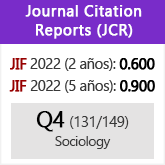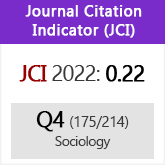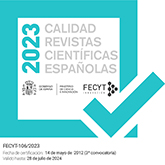La feminización de la dinámica política municipal. El caso de los municipios españoles
DOI:
https://doi.org/10.3989/ris.2010.09.11Palabras clave:
Asociaciones de mujeres, Estructura de oportunidades políticas, Gobierno local, ResponsividadResumen
El análisis de la responsividad de los gobiernos locales a las asociaciones y movimientos sociales ha sido un asunto central en el estudio de la dinámica socio-política local. No obstante, las asociaciones de mujeres vienen siendo un actor olvidado en estos análisis, a pesar de la importancia de su análisis a nivel nacional. En este trabajo se formula una propuesta analítica para dar cuenta de la importancia de la feminización de las estructuras de oportunidades políticas a nivel local. Esta se aplica al caso español mediante el análisis de una encuesta representativa entre municipios. Los resultados muestran la importancia de la feminización de la estructura de oportunidades políticas como la presencia de mujeres entre las élites políticas municipales
Descargas
Citas
Abrar, S., Joni Lovenduski y Helen Margetts. 1998. “Sexing London: The Gender Mix of Urban Policy Actors”. International Political Science Review 19:147-171. http://dx.doi.org/10.1177/019251298019002005
Achtgerberg, P. 2006. Considering Cultural Conflict. Maastricht: Shaker Publishing
Actchinson, A. e Ian Down. 2009. “Women Cabinet Ministers and Female-Friendly Social Policy”. Poverty and Public Policy 1:1-23.
Aiken, M. y R. Alford. 1970. “Community Structure and Innovation: The case of Public Housing”. American Political Science Review, September: 843-864. http://dx.doi.org/10.2307/1953467
Andrew, C. 1995. “Getting Women”s Issues on the Municipal Agenda: Violence Against Women”. Pp. 99-118 en Gender in Urban Research, coordinado por J. A. Garber and R. S. Turner. Thousand Oaks, Ca.: Sage.
Banaszak, Lee Ann; Karen Beckwith and Dieter Rucht. 2003. Women’s Movements Facing the Reconfigured State. Cambridge: Cambridge University Press.
Bashevkin, Sylvia. 1985. Women and Politics in WesternEurope. Londres: Frank Cass.
Beckwith, K. and Kimberly Cowell-Meyers. 2007. “Sheer Numbers: Critical Representation Thersholds and Women’s Political Representation”. Perspectives on Politics 5:553-565. http://dx.doi.org/10.1017/S153759270707154X
Beck, S. 2001. “Acting as women: The Effects and Limitations of Gender in Local Governance”. Pp. 49-67 en The Impact of Women in Public Office, edited by S. Carroll. Indiana: Indiana University Press.
Boles, J. 2001. “Local Elected Women and Policy-Making: Movement Delegates or Feminist Trustees?”. Pp. 68-88 en The Impact of Women in Public Office, edited by S. Carroll. Indiana: Indiana University Press.
Bratton, K. A. y Leornard P. Ray. 2002. “Descriptive Representation, Policy Outcomes, and Municipal Day-Care Coverage in Norway”. American Journal of Political Science 46:428-437. http://dx.doi.org/10.2307/3088386
Browning, R., Dale R. Marshall y David H. Tabb. 1984. Protest Is not Enough. The Struggle of Blacks and Hispanics for Equality in Urban Politics. Los Angeles: University of California Press.
Budge, I., Hans-Dieter Klingemann; Anfrea Volkens; Judith Baray Eric Tanenbaum. 2001. Mapping Policy Preferences. Oxford: Oxford University Press.
Bustelo, M. y Candice Ortbals. 2007. “The Evolution of Spanish State Feminism. A Fragmented Landscape”. Pp. 201-223 en Changing State Feminism: Women’s Policy Agencies Confront Shifting Institutional Terrain, edited by J. Outshoorn and J. Kasmtola. Palgrave: MacMillan.
Carroll, S. 2001. “Representing Women: Women State Legislators as Agents of Policy-Related Change”. Pp. 3-21 en The Impact of Women in Public Office, edited by S. Carroll. Indiana: Indiana University Press.
Castells, M. 1986. La ciudad y las masas. Madrid: Alianza.
Childs, S. y Mona Lena Krook. 2006. “Should Feminist Give Up on Critical Mass? A Contingent Yes”. Politics&Gender 2:522-530. http://dx.doi.org/10.1017/S1743923X06251146
Clark, T. N. 1998. “Assessing the New Political Culture by Comparing Cities Around the world”. Pp. 93-193 en The New Political Culture. Boulder, edited by T. N. Clark and V. Hoffman-Martinott. CO: Westview Press
Clark. T. N. 1994. “Race and Class versus the New Political Culture”. Pp. 21-78 en Urban Innovations, coordinado por T. N. Clark. Londres: Sage.
Clark, T. N. 1973. Community Power and Policy Outputs. Londres: Sage.
Dahlerup, D. 1988. “From Small to Large Minority: Women in Scandinavian Politics”. Scandinavian Political Studies 11/4:275-98. http://dx.doi.org/10.1111/j.1467-9477.1988.tb00372.x
Dalherup, D. 2006a. “The Story of the Theory of Critical Mass”. Politics&Gender 2:511-522.
Dahlerup, D. 2006b. Womens, quotas and politics. New Cork: Routledge.
Delgado, I. y Miguel Jerez. 2008. “Mujer y política en España: un análisis comparado de la presencia femenina en las asambleas legislativas (1977-2008).” Revista Española de Ciencia Política 19:41-78.
Eisinger, P. K. 1973. “The Conditions of Protest Behaviour in American Cities.” American Political Science Review, March: 11-28. http://dx.doi.org/10.2307/1958525
Fainstein, N. I. y Susan Fainstein. 1972. Urban Political Movements. The Search of Power by Minority Groups in American Cities. New Jersey: Prentice-Hall, Inc.
Font, J., ed. 2001. Ciudadanos y decisiones públicas. Barcelona: Ariel.
Foster, M. K. y Agnes Meinhard. 2005. “Women”s Voluntary Organizations in Canada: Bridgers, Bonders, or Both?”. Voluntas 16:143-159. http://dx.doi.org/10.1007/s11266-005-5695-03
Garber, J. A. y Robyne Turner. 1995. “Introduction”. Pp. X-XXVI en Gender in Urban Research, edited by J. A. Garber y Robyne Turner. Londres: Sage.
Gelambí, M. 2005. “La pràctica local: organizaciò de la introducciò de les polítiques de génere als ajuntaments de Catalunya”. Pp. 79-102, en Repensar les polítiques de gènere des de l”àmbit local, edited by María de la Fuente. Barcelona: Institut de Ciénces Politiques i Socials.
Grey, S. 2006. “Numbers and Beyond: The Relevance of Critical Mass in Gender Research”. Politics&Gender 2:492-502. http://dx.doi.org/10.1017/S1743923X06221147
Hahn, H. 1970. “Civic Responses to Riots”. Public Opinion Quaterly :101-107.
Hajnal, Z. y Terry N. Clark. 1998. “The Local Interest-Group System: Who Governs and Why?”. Social Science Quarterly 79:226-241.
Hoggart, Keith y Terry N. Clark. 2000. Citizen responsive Government. Nueva York: JAI Press.
Imbroscio, 1998. Reconstructing City Politics. Londres: Sage.
Katzenstein, M. and Carol McClurg Mueller. 1987. The Women”s Movements of the United Statesand Western Europe. Philadelphia: Temple University Press.
Lineberry, R. L. y Edmund P. Fowler. 1967. “Reformism and Public Policies in American Cities”. American Political Science Review 61:701-716. http://dx.doi.org/10.2307/1976089
Lipsky, M.1968. “Protest as a Political Resource”. The American Political Science Review 62.4:11441158.
López Nieto, L. e Irene Delgado. 1994. “Innovación urbana española: ¿Una nueva clase política? Revista de Estudios Políticos 86:313-343.
Lovenduski, J. 2001. “Women and Politics, Critical Mass or Minority Representation”. Pp. 179-174 en Britain Votes, edited by P. Norris. Oxford: Oxford University Press.
Lovenduski, J. y P. Norris. 2002. “Westminster women: The politics of presence”. Political Studies 51:84-103. http://dx.doi.org/10.1111/1467-9248.00414
Lovenduski, J. 2005. State feminism and the political representation of women. Cambridge: Cambridge University Press. http://dx.doi.org/10.1017/CBO9780511490996
Lowe, S. 1986. Urban Social Movements. The City after Castells. Londres: MacMillan.
Magnier, A., Clemente J. Navarro y Giuseppe Russo. 2006. “Urban Systems as Growth Machines?. Mayors” Governing Networks against Glocal Indeterminacy.” Pp. 201-220, in The European Mayor, edited by H. Bäck, H. Hienelt and A. Magnier. Wiesbaden: Vs Verlag Für Sozialwissenschaften.
McAdams, D., John D. McCarthy y Mayer N. Zald. eds. 1996. Comparative Perspectives on Social Movements. Cambridge: Cambridge University Press.
Martínez, E. 2005. “Las organizaciones de mujeres y su capacidad de influencia en la agenda política local: amenazas y oportunidades en la interlocución con los poderes públicos”. Pp. 79-102, en Repensar les polítiques de gènere des de l”àmbit local, edited by María de la Fuente. Barcelona: Institut de Ciénces Politiques i Socials.
Marwell, G. y Pamela Oliver. 1992. The critical Mass in Collective Action. Cambridge: Cambridge University Press.
Mateo, M. 2005. Representing Women? Female Legislators in West European Parlaments. Essex: ECPR.
Mazur, A. G. 2002. Theorizing Feminist Policy. Londres: Oxford University Press.
McBride, D. E and Amy G. Mazur. 2006. “Women’s Movements, Women’s Policy Agencies and Democratization”. Council for European Studies Meeting. Chicago, March 2006.
McBride, D. and Amy G. Mazur. 1995. Comparative State Feminism. Londres: Sage.
Meyer, D. S. and Debra C. Minkoff. 2004. “Conceptualizing Political Opportunities”. Social Forces 82.4:1457-1492. http://dx.doi.org/10.1353/sof.2004.0082
Minkoff, D. C. 2002. “The Emergence of Hybrid Organizational Forms: Combining Identity-Based Service Provision and Political Action”. Nonprofit and Voluntary Sector Quarterly 31:377-401. http://dx.doi.org/10.1177/0899764002313004
Molineaux, M. 1985. “Mobilization Whitouth Emancipation? Women’s Interest, the State, and Revolution in Nicaragua”. Feminist Studies 11, 2: 227-254. http://dx.doi.org/10.2307/3177922
Morales, L. y F. Mota. 2006. “El asociacionismo en España”. Pp. 77-104 en Ciudadanos, asociaciones y participación en España, coordinado por Montero, Font y Torcal. Madrid: CIS.
Mota, F. 1998. “La realidad asociativa en España.” Pp. 37-64, en ?Existe sociedad civil en Espana?, coordinado por Joan Subirats. Madrid: Fundación Encuentro.
Murillo de la Vega, S. 2003. Ciudadanía Activa. Asociacionismo de Mujeres. Madrid: Comunidad de Madrid.
Navarro, C. J. 2008. “Sobre la naturaleza y rendimientos del puente democrático participativo”. Inguruak 45:23-41.
Navarro, C. J. (2009): “Local political opportunities structures as mayor actiona rena”, Pp. 367-396, en Local Poltical Leadership in Europe. Town Chief, City Boss or Loco President?, coordinado por H. Raynert, Kristoff Steyvers, Pascal Delwitt and Jean-Beniot Pilet. Bruselas: Vaden Broele Publishers.
Navarro, C. J., Annick Maginer y María A. Ramírez. 2008. “Local governance as government-business cooperation in western democracies. Analising local and intergovernmental effects by multi-level comparison”. International Journal of Urban and Regional Research 32:531-547. http://dx.doi.org/10.1111/j.1468-2427.2008.00816.x
Navarro, C. J. y María J. Rodríguez. 2009. Sistemas locales de bienestar y gobernanza multinivel. Valencia: Tirant lo blanch.
Nelson, Barbara J. and Najma Chowdhury. 1994. Women and Politics Worldwide. New Haven: Yale University Press.
Offe, C. y Helmut Wiesenthal. 1980. “Two logics at collective action: theoretical notes on social class and organizational form”. Political Power and Social Theory 1:67-115.
Ortbals, C. 2008. “Subnational Politis in Spain: New Avenues for Feminist Policymaking and Activism”. Politics and Gender 4:93-119. http://dx.doi.org/10.1017/S1743923X08000044
Peterson, P. E. 1981. City Limits. Chicago: The University of Chicago Press.
Philips, A. 1995. The Politics of Presence. Oxford: Clarendon Press.
Piven, F. F y Richard A. Cloward. 1977. Poor Peoples movements. Why they succeed, how they fail. Nueva York: Vintage Books.
Rodil, D. 1998. “Rethinking Local Policy Analysis: The Challenge of Culture to Political Economy”. Annual Meeting of the Midwest Political Science Association. Chicago.
Rodríguez, M.J. (2010). Género participación y sistemas locales de bienestar, Memoria final de Proyecto. Madrid: Instituto de la Mujer.
Ruiz, S. 2009. “Sombra aquí y sombra allá: relaciones y avatares entre el movimiento de mujeres y las instituciones.” Pp. 93-117 en Polítiques de Gèner i Participació Ciudadana al Món Loca, coordinado por De la Fuente y Freixenet. Barcelona: Institut d Ciènces Politiques i Socials.
Saltzstein, G. H. 1989: “Black mayors and Police Policy”. The Journal of Politics 51:525-644. http://dx.doi.org/10.2307/2131494
Saltzstein, G. H 1986. “Female Mayors and Women in Municipal Jobs”. American Journal of Political Science 30:140-164. http://dx.doi.org/10.2307/2111298
Sampedro, R. 1992. Administración local y Políticas de Igualdad de la Mujer. Madrid: FEMP.
Savicth, H. V. y Paul Kantor. 2004. Cities in the International Marketplace. Princeton: Princeton University Press.
Schumaker, Paul y Russel W. Getter. 1977. “Responsiveness Bias in 51 American Cities”. American Journal of Political Science 21:247-281. http://dx.doi.org/10.2307/2110494
Schumaker, Paul and Marisa Kelly.1999. “Affirmative Action, Principles of Justice, and the Evolution of Urban Theory”. Urban Affairs Review 34:619-640 http://dx.doi.org/10.1177/10780879922184112
Schumaker, P. 1975. “Policy Responsiveness to Protest Group Demands”. Journal of Politics, 38:488521.
Sharp, E. B. 2005. Morality Politics in American Cities. Lawrence: The Kansas University Press.
Stone, C. N. 1993. “Urban Regimes and the Capacity to Govern: A Political Economy Approach”. Journal of Urban Affairs 15.1:1-28 http://dx.doi.org/10.1111/j.1467-9906.1993.tb00300.x
Sylvia, R. D. and P. J. Hass. 1998. “Affirmative Action in Municipal Government: Political, Structural and Demographic Determinants of Alternative Strategies”. The Social Science Journal 35:615-625. Threlfall, Monica, ed. 1996. Mapping theWomen’s Movement. Londres: Verso.
Valiente, C. 1999. “Feminismo de Estado en los ayuntamientos de la Comunidad Autónoma de Madrid”. Gestión y Anáisis de Políticas Públicas 13/14:173-189.
Valiente, C. 2005. “La efectividad de los organismos de igualdad: el estado de la cuestión en el ámbito internacional”. Pp. 79-102 en Repensar les polítiques de gènere des de l”àmbit local, editado por María de la Fuente. Barcelona: Institut de Ciénces Politiques i Socials.
Valiente, C. 2006. El Feminismo de Estado en España: El Instituto de la Mujer (1983-2003). Valencia: Institut Universitari d”Estudis de la Dona.
Verge, T. 2008. “Cuotas voluntarias y legales en España. La paridad a examen”. Revista Española de Investigaciones Sociológicas 123: 123-150.
Descargas
Publicado
Cómo citar
Número
Sección
Licencia
Derechos de autor 2012 Consejo Superior de Investigaciones Científicas (CSIC)

Esta obra está bajo una licencia internacional Creative Commons Atribución 4.0.
© CSIC. Los originales publicados en las ediciones impresa y electrónica de esta Revista son propiedad del Consejo Superior de Investigaciones Científicas, siendo necesario citar la procedencia en cualquier reproducción parcial o total.Salvo indicación contraria, todos los contenidos de la edición electrónica se distribuyen bajo una licencia de uso y distribución “Creative Commons Reconocimiento 4.0 Internacional ” (CC BY 4.0). Puede consultar desde aquí la versión informativa y el texto legal de la licencia. Esta circunstancia ha de hacerse constar expresamente de esta forma cuando sea necesario.
No se autoriza el depósito en repositorios, páginas web personales o similares de cualquier otra versión distinta a la publicada por el editor.

















